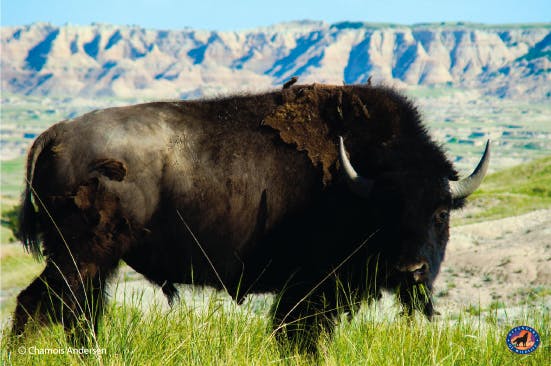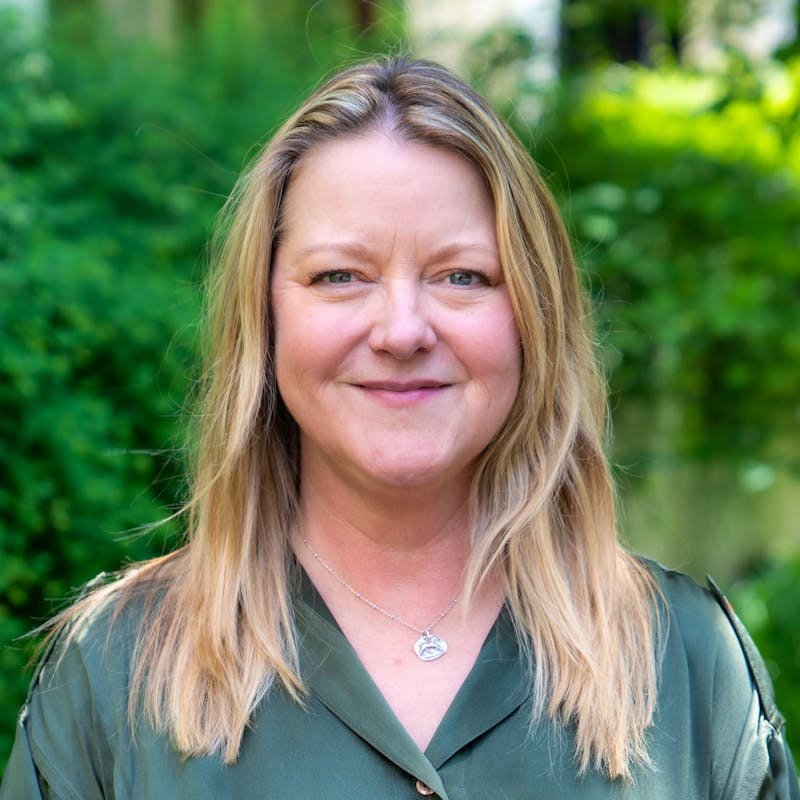Defenders is working to help restore an icon to the plains, the bison of Badlands National Park.
The American bison and Badlands National Park go hand in hand. The Great Plains ecosystem has long included these large, hearty beasts that once numbered in the millions.
Prior to European settlement, about 30 million bison inhabited North America. But by the late 19th century, fewer than 1,000 could be found on the continent, with only a handful of wild bison left in the American West. Badlands National Park, with its rugged landscape of layered rock formations and sprawling grasslands, hosts a variety of wildlife species and offers the perfect backdrop for bringing back the bison to its native range.
For conservationists, restoring bison to the Badlands means this grazer can once again play an important ecological role on the plains. The animals graze heavily on native grasses and disturb the soil with their hooves, allowing many plant and animal species to flourish. Prairie dogs prefer lands grazed by bison for establishing their colonies. Prairie dog colonies in turn, provide food for the endangered black-footed ferret that preys on prairie dogs, which large birds of prey and coyotes also prey on. For Americans, it means bringing back an iconic wildlife species to the West and giving the country’s official national mammal a second chance.
Bringing the Bison Back to the Badlands: The Efforts Begin
 Today, thanks to major conservation efforts and coordinated collaborations, a healthy herd of bison is thriving in Badlands National Park.
Today, thanks to major conservation efforts and coordinated collaborations, a healthy herd of bison is thriving in Badlands National Park.
The effort to bring bison back to their historic range in Badlands National Park first began with the reintroduction of 50 animals to the park in the 1960’s from Theodore Roosevelt National Park, followed by 20 more in the 1980’s from Colorado National Monument.
More recently, park officials joined forces with several partner groups on a project to expand the area open to bison within the park’s borders. In cooperation with the U.S. Forest Service and nonprofit organizations, the park completed a land swap with a neighboring ranch, which will allow bison to move freely into the eastern portion of the park where there are more than 80,000 additional acres to roam. Before bison could be released into this new area, it first needed fencing to be installed around the park boundary to keep bison out of adjacent ranches and from intermingling with cattle. Defenders of Wildlife, along with our partners at the World Wildlife Fund and the National Park Foundation, provided the significant funding needed to match the federal funding for the fence’s construction.
“With this project, the stars aligned,” Childers said. Congress appropriated funds in the form of competitive grants made available to the National Park Service for the National Parks Centennial. Those grants required a 50 percent match and with the quick and hard work of partners like Defenders of Wildlife, World Wildlife Fund, and the National Park Foundation, the national philanthropic partner of the National Park Service, those matching funds as well as additional funds were secured resulting in more than $1.2 million for bison conservation in the Badlands.
A Healthy Herd

After many years of good stewardship and the park’s continued partnership with conservation groups to restore bison to their native lands, today’s herd count is upwards of 1,200 animals. “These bison are inhabiting some of the last remaining mixed grass prairie grasslands in the nation,” said Eddie Childers, wildlife biologist for Badlands National Park. “We know these animals are good for the prairie and rangeland health, but we were also motivated with this project so our visitors could once again see bison in the wild,” Childers said. This partnership, which has been bolstered by the support of Defenders of Wildlife, the World Wildlife Fund, and the National Park Foundation, is truly a conservation success story.
With the bison population above the 1,000-animal threshold, the long-term genetic integrity of the herd is believed to be stable and therefore, this “conservation herd” has a high probability of being sustainable in the long term. Most conservation herds number less than 500 individuals; only a handful have reached the 1,000-animal benchmark.
Celebrating Success
To honor the conservation partners for their collaboration and stewardship, Badlands National Park recently held an all-day event on June 1st for the major donors and partners. The event, which was held on a scenic bluff overlooking the park, included a field tour of the Sage Creek unit where the herd is located, as well as a dinner with live music and speeches by National Park Service officials and the conservation partners who raised critical funding for the cause.
Defenders of Wildlife was recognized during the event and as our representative in attendance, I spoke on behalf of Defenders about the important ecological role bison play and how they bring balance to their environment.
A focal point of the celebration was when, James Cross, council member of the Oglala Sioux Tribe of the Lakota people, conducted a Lakota blessing to “bring the family home,” the “tatanka,” translated as “buffalo” or “buffalo bull.”
The lives of Native Americans have revolved around the bison’s migration across the vast plains of North America—from Canada to Mexico, the Pacific Northwest to the Appalachian Mountains—for centuries.
“For thousands of years we have had a relationship with this animal and we still do today,” Cross said. This relationship can once again prosper with Badlands National Park’s determination to return the bison back to its historic range and with the support of the Lakota people and the Pine Ridge Indian Reservation in South Dakota.
“Our ancestors depended on the bison; it was our food, our clothing our shelter,” said Cross, as he held up an eagle feather to begin the blessing of the bison.
Defenders of Wildlife is committed to this recovery effort to reestablish the American bison in the Badlands and to establish additional conservation herds of 1,000 or more animals on large landscapes in other national parks and public and tribal lands across the West.
Follow us on social media to stay up-to-date on the status of our bison conservation efforts and other developments important to wildlife conservation and our work. Don’t forget to sign up for our emails where you will get all the latest news and action alerts to support wildlife.





